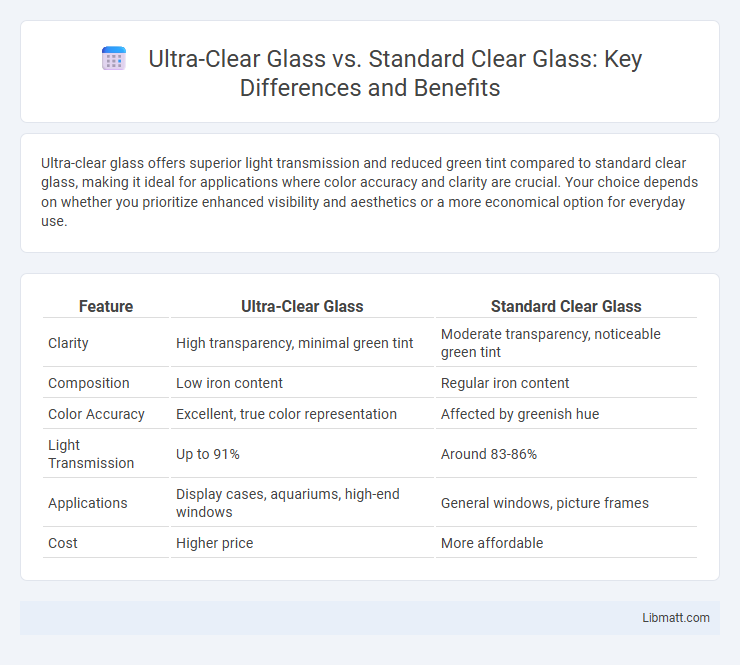Ultra-clear glass offers superior light transmission and reduced green tint compared to standard clear glass, making it ideal for applications where color accuracy and clarity are crucial. Your choice depends on whether you prioritize enhanced visibility and aesthetics or a more economical option for everyday use.
Table of Comparison
| Feature | Ultra-Clear Glass | Standard Clear Glass |
|---|---|---|
| Clarity | High transparency, minimal green tint | Moderate transparency, noticeable green tint |
| Composition | Low iron content | Regular iron content |
| Color Accuracy | Excellent, true color representation | Affected by greenish hue |
| Light Transmission | Up to 91% | Around 83-86% |
| Applications | Display cases, aquariums, high-end windows | General windows, picture frames |
| Cost | Higher price | More affordable |
Introduction to Ultra-Clear Glass and Standard Clear Glass
Ultra-clear glass, also known as low-iron glass, offers significantly higher transparency and fewer impurities compared to standard clear glass, making it ideal for applications demanding maximum clarity and true color representation. Standard clear glass contains more iron content, which imparts a greenish tint that can affect the visual quality of displays, aquariums, and architectural elements. Choosing ultra-clear glass enhances Your viewing experience by delivering a more vibrant and distortion-free appearance, especially in settings where precision and aesthetics are critical.
Composition and Manufacturing Differences
Ultra-clear glass contains significantly lower iron oxide levels than standard clear glass, resulting in higher light transmission and reduced greenish tint. It is manufactured using high-purity raw materials and advanced refining processes to minimize impurities, enhancing optical clarity. Standard clear glass typically incorporates more iron content, which affects its color and transparency, and undergoes less stringent purification during production.
Optical Clarity and Light Transmission
Ultra-clear glass offers superior optical clarity with minimal green tint, enhancing true color representation and improving visual acuity compared to standard clear glass. It transmits up to 91% of visible light, allowing more natural light to pass through windows while reducing glare and reflections. This high light transmission makes ultra-clear glass ideal for applications requiring precise visibility and brightness, such as display cases, aquariums, and premium architectural glazing.
Color and Visual Appearance Comparison
Ultra-clear glass features a significantly lower iron content than standard clear glass, resulting in higher light transmission and a more transparent, almost invisible appearance. The reduced greenish tint in ultra-clear glass enhances color accuracy and clarity, making it ideal for applications where true color representation is critical, such as in art displays or high-end storefronts. Standard clear glass, with its higher iron content, often exhibits a subtle green hue that can slightly distort colors and reduce overall brightness.
Strength and Durability
Ultra-clear glass offers enhanced strength and durability compared to standard clear glass due to its higher purity and reduced iron content, which minimizes discoloration and improves structural integrity. Its advanced manufacturing process results in increased resistance to scratches, impacts, and environmental stress, making it ideal for applications demanding long-lasting performance. When you choose ultra-clear glass, your installation benefits from superior durability and a clearer, more visually appealing finish.
Common Applications and Uses
Ultra-clear glass is predominantly used in display cases, museum exhibits, and luxury storefronts where maximum light transmission and color accuracy are crucial. Standard clear glass finds common applications in residential windows, picture frames, and basic partitions where cost-effectiveness and general clarity suffice. Both types serve distinct functional needs, with ultra-clear glass enhancing visual clarity and aesthetic appeal in high-end environments.
Energy Efficiency and Performance
Ultra-clear glass offers superior energy efficiency compared to standard clear glass due to its low iron content, which enhances visible light transmission and reduces solar heat gain. This high performance minimizes the need for artificial lighting and climate control, lowering energy consumption in buildings. Standard clear glass typically has lower visible light transmittance and higher solar heat gain, resulting in less effective thermal insulation and increased energy costs.
Cost Differences and Value
Ultra-clear glass typically costs 20-40% more than standard clear glass due to its higher purity and reduced green tint, which enhances light transmission and clarity. This cost premium translates to superior visual aesthetics and is especially valuable in applications requiring true color representation, such as in display cases, aquariums, and high-end architecture. Long-term value arises from ultra-clear glass's ability to improve natural lighting efficiency and customer appeal, potentially offsetting initial higher expenses through energy savings and increased product visibility.
Environmental Impact and Sustainability
Ultra-clear glass contains fewer impurities and iron oxide, resulting in higher light transmission and reduced energy consumption in buildings, which lowers their carbon footprint compared to standard clear glass. The manufacturing process of ultra-clear glass often emphasizes eco-friendly techniques, contributing to better sustainability through reduced waste and lower emissions. Recycling ultra-clear glass also tends to be more efficient, further minimizing environmental impact over its lifecycle.
Choosing the Right Glass for Your Project
Ultra-clear glass offers higher light transmission and minimal green tint compared to standard clear glass, making it ideal for projects requiring true color representation and maximum clarity. This glass type enhances visual appeal in displays, windows, and aquariums by providing sharper views with less distortion. Choosing ultra-clear glass can elevate your project's aesthetic and functional quality, especially where optical precision matters.
ultra-clear glass vs standard clear glass Infographic

 libmatt.com
libmatt.com